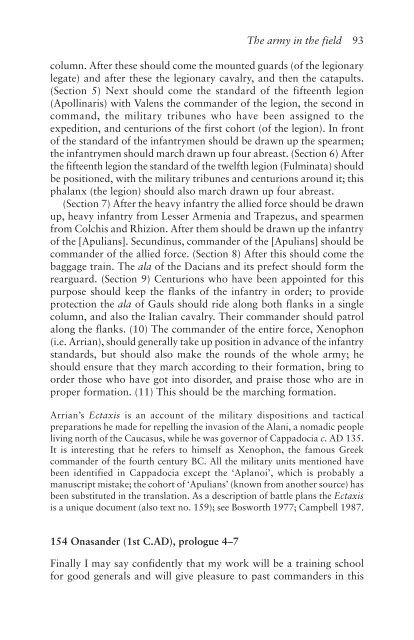The Roman Army, 31 BC–AD 337: A Sourcebook
The Roman Army, 31 BC–AD 337: A Sourcebook
The Roman Army, 31 BC–AD 337: A Sourcebook
You also want an ePaper? Increase the reach of your titles
YUMPU automatically turns print PDFs into web optimized ePapers that Google loves.
<strong>The</strong> army in the field 93<br />
column. After these should come the mounted guards (of the legionary<br />
legate) and after these the legionary cavalry, and then the catapults.<br />
(Section 5) Next should come the standard of the fifteenth legion<br />
(Apollinaris) with Valens the commander of the legion, the second in<br />
command, the military tribunes who have been assigned to the<br />
expedition, and centurions of the first cohort (of the legion). In front<br />
of the standard of the infantrymen should be drawn up the spearmen;<br />
the infantrymen should march drawn up four abreast. (Section 6) After<br />
the fifteenth legion the standard of the twelfth legion (Fulminata) should<br />
be positioned, with the military tribunes and centurions around it; this<br />
phalanx (the legion) should also march drawn up four abreast.<br />
(Section 7) After the heavy infantry the allied force should be drawn<br />
up, heavy infantry from Lesser Armenia and Trapezus, and spearmen<br />
from Colchis and Rhizion. After them should be drawn up the infantry<br />
of the [Apulians]. Secundinus, commander of the [Apulians] should be<br />
commander of the allied force. (Section 8) After this should come the<br />
baggage train. <strong>The</strong> ala of the Dacians and its prefect should form the<br />
rearguard. (Section 9) Centurions who have been appointed for this<br />
purpose should keep the flanks of the infantry in order; to provide<br />
protection the ala of Gauls should ride along both flanks in a single<br />
column, and also the Italian cavalry. <strong>The</strong>ir commander should patrol<br />
along the flanks. (10) <strong>The</strong> commander of the entire force, Xenophon<br />
(i.e. Arrian), should generally take up position in advance of the infantry<br />
standards, but should also make the rounds of the whole army; he<br />
should ensure that they march according to their formation, bring to<br />
order those who have got into disorder, and praise those who are in<br />
proper formation. (11) This should be the marching formation.<br />
Arrian’s Ectaxis is an account of the military dispositions and tactical<br />
preparations he made for repelling the invasion of the Alani, a nomadic people<br />
living north of the Caucasus, while he was governor of Cappadocia c. AD 135.<br />
It is interesting that he refers to himself as Xenophon, the famous Greek<br />
commander of the fourth century BC. All the military units mentioned have<br />
been identified in Cappadocia except the ‘Aplanoi’, which is probably a<br />
manuscript mistake; the cohort of ‘Apulians’ (known from another source) has<br />
been substituted in the translation. As a description of battle plans the Ectaxis<br />
is a unique document (also text no. 159); see Bosworth 1977; Campbell 1987.<br />
154 Onasander (1st C.AD), prologue 4–7<br />
Finally I may say confidently that my work will be a training school<br />
for good generals and will give pleasure to past commanders in this



